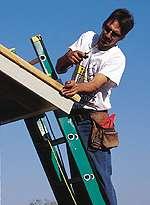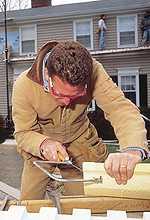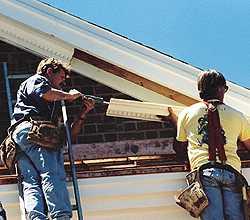Business Articles - On the Job
Articles & Tips
Wood composite, plastic, and fiber-cement trim products promise to hold paint better than solid wood.
More and more customers are insisting on low-maintenance exteriors, while builders are facing rising prices for quality lumber. So when it comes time to choose exterior trim, many builders are considering new engineered alternatives to solid wood. Some builders may be looking for a lower-cost alternative to clear cedar or redwood. Others may be willing to pay extra for a premium product that promises to outlast wood. In all cases, builders are looking for something that won't need to be painted frequently.
There are a bewildering number of products available. These products can be grouped into three general categories: engineered wood, fiber-cement, and plastics. In general, engineered wood and fiber-cement are less expensive than solid wood, and much less expensive than the plastics. Most of the plastic trims cost 20 to 60 percent more than cedar, except for polyurethane trim, which costs about four times as much.
 |
Fiber-cement trim, like this James Hardie product, can be used with almost any type of siding. |
Engineered Wood
Engineered wood products are variations on the basic recipe of wood
fiber and glue. Evaluating the claims of composite trim manufacturers can be
difficult, since most are unwilling to reveal the details of their
manufacturing processes. After the widely reported failures of some hardboard
and OSB siding products in the early 1990s, builders may be reluctant to accept
manufacturers' claims that their trim products are weather-resistant. When
asked how their engineered trims differ from the materials involved in the
class-action siding lawsuits, manufacturers speak vaguely of "optimized resin
content," "a proprietary edge seal," or "chemical treatment for rot
resistance." Only long-term field experience will provide adequate assurance
that these products can withstand weather exposure.
Swollen when wet. Most engineered wood trims, like wood, will expand when wet. With solid wood, the expansion occurs in thickness and width, but not significantly in length. In contrast, most engineered woods expand in all directions, including length, as they take on moisture. When installing a 40-foot fascia of engineered wood, the installer must allow for expansion, or the material may buckle.
Louisiana-Pacific, the manufacturer of SmartStart trim, requires a 3/16-inch gap at end-to-end butt joints. The same gap is required when installing Max Trim particleboard. Masonite, manufacturer of Miratec, requires a 1/8-inch gap at butt joints. Some, but not all, manufacturers permit the use of scarf joints.
Installation instructions. Installers may be put off by installation instructions that warn against penetrating the face of a piece of trim. For example, Temple-Inland, which makes TrimCraft hardboard trim, specifically forbids countersinking nails: "Drive nail heads flush with the trim surface, and do not set or countersink." Similarly, the instructions for ABTco's TrimBoard advise, "Nails should be driven flush with or slightly above the surface." To some eyes, leaving prominent fastener heads makes the trim look riveted to the building. Although most engineered trim manufacturers discourage countersinking, some products - including SmartStart, Max Trim, and Miratec - permit countersinking as long as the nail holes are caulked.
Because the interiors of engineered trim products are more vulnerable to moisture than their faces, several manufacturers recommend that their trim not be ripped. The installation instructions for Clear Lam MDO trim advise, "Clear Lam fascia/trim is factory sealed and we do not recommend that the product be ripped in the field." SmartStart warns, "Ripping of the trim and fascia is not recommended." Since installation of fascia and soffit boards often requires ripping, these warnings are worrisome. After making it clear that ripping is not recommended, both manufacturers proceed to specify how to paint ripped edges — should the installer choose to violate the manufacturer's recommendations.
Hardboard trim. To manufacture hardboard, green wood chips are heated with steam and hot water, then mechanically ground. Resins (chiefly phenol formaldehyde) are added and the fibers are consolidated under pressure to form hardboard (see Figure 1).
|
|||
| Figure 1. Most hardboard trim, like Georgia-Pacific's Prime Trim (left), is sold preprimed. Many hardboard trim manufacturers emboss their products with a surface texture that resembles wood grain, as on this TrimCraft fascia (right). | |||
There are at least five manufacturers of hardboard exterior trim (ABTco, Collins Products, Georgia-Pacific, Masonite, and Temple-Inland). All of them sell their hardboard trim in only one length, 16 feet. This limitation may result in high levels of waste — when installing 9-foot corner boards, for example.
Anton Tenwolde, a research physicist at the U.S. Forest Products Lab in Madison, Wisc., has been conducting ongoing tests of hardboard siding. "With hardboard, you can get a wide variety of properties," says Tenwolde. "We're performing swell tests, which involve cyclical wetting and drying. There's quite a range in the water absorption properties. All of the samples meet the minimum AHA [American Hardboard Association] standard, but you still get quite a bit of variation from one material to the next — even in samples from the same mill."
In spite of these reported variations, many builders feel that as long as hardboard trim is carefully installed and well painted, it can provide good service (see "On Site with Prime Trim," JLC, 6/95).
OSB trim. There is only one oriented-strand board product marketed for use as exterior trim, Louisiana-Pacific's SmartStart. SmartStart's OSB core has a resin-impregnated paper overlay. It is usually sold preprimed, although an unprimed version, called Fiberstrate, is available. Like the hardboard trims, SmartStart is available only in 16-foot lengths.
SmartStart's installation instructions warn that the product must be "applied in a manner that will not allow water to intrude." This statement is not reassuring, since virtually no siding or trim can be expected to exclude wind-driven rain. When asked whether this advice is a disclaimer devised by lawyers, Tom Reierson, a technical representative from Louisiana-Pacific, answered, "I don't think that statement was put there by someone with construction details in mind."
Although SmartStart can be mitered, the manufacturer recommends leaving a 3/16-inch gap at miter joints, which would tend to spoil the effect.
Particleboard trim. In general, most particleboards are suitable for interior use only. However, one company, Smurfit Newsprint Corp., sells a particleboard trim product, Max Trim, for exterior use. Particleboard is manufactured from sawdust or planer shavings. Like hardboard, it is bonded together by resins under heat and pressure.
Both faces of Smurfitís Max Trim are covered with a resin-impregnated paper overlay made from recycled newsprint. Max Trim is available only in 16-foot lengths.
The manufacturer claims that the material can be mitered. If an adhesive is desired, construction adhesive can be used. The material can be ripped, but if the ripped edge is exposed, it should be painted.
MDO trim. MDO, or medium-density overlay, is plywood faced with a layer of smooth resin-impregnated paper. Since MDO is assembled with exterior glues, it can be exposed to the weather; in fact, MDO is sometimes used for siding. The paper facing, which takes paint well, solves the problem of veneer checking. MDO is commonly available in sheets up to 10 feet long. "Generally, the durability of MDO and other exterior grades of plywood are equal," says Merrit Kline, product support specialist at APA. MDO is an excellent soffit material.
Most MDO is sold in 4-foot-wide panels — not the ideal shape for fascia boards and corner trim. To respond to the need for MDO configured for use as exterior trim, Pacific Wood Laminates developed Clear Lam, which is available in dimensions similar to sawn lumber, in lengths up to 24 feet.
Unlike MDO panels, in which adjacent veneer plies are oriented at 90 degrees to each other, Clear Lam consists of an MDO face over laminated-veneer lumber, in which most, but not all, of the plies run lengthwise (Figure 2). The crossband plies help reduce cupping. Clear Lam has an impressive ten-year non-prorated warranty against delamination.
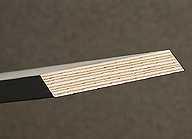 |
Figure 2. Clear Lam trim consists of an MDO paper face over a laminated-veneer lumber core. |
Clear Lam comes preprimed. Voids on the edges are filled and sealed, and the material can be mitered. Because Clear Lam has good dimensional stability, there is no need to leave a gap for expansion at butt joints.
Although Clear Lam costs almost twice as much as the least expensive hardboard trims, it has a proven record of weather resistance, and is less likely than hardboard to swell in length.
Fiber-Cement Trim
Fiber-cement siding has gained a good reputation for its resistance to fire
and rot, and its use is growing rapidly. Until recently, however, fiber-cement
trim products have been limited to thin materials — generally between 1/4
and 1/2 inch thick. The main problem with developing full-thickness
fiber-cement trim is the high density of the material, which is made of
Portland cement, sand, and wood fiber (See ""). When conventional fiber-cement
is manufactured as thick as 3/4 or 7/8 inch, the trim becomes awkward to handle
and hard to nail. "If fiber-cement of the same density as our siding was made
7/8 inch thick, it would be difficult to get a nail through," says Todd
Griesemer, an engineer at Cemplank.
Cemplank took on the technical challenge of developing a low-density fiber-cement. In the fall of 1998, they began selling a 7/8-inch-thick fiber-cement trim called Cemtrim, which is less dense than Cemplank siding. Although the density has been reduced, the material is still heavy: A 10-foot length of 1x12 Cemtrim weighs 53 pounds, making it about twice as dense as pine or cedar.
Recently, James Hardie introduced their own low-density fiber-cement trim, which they call Hardie Low Density, or HLD trim. It is 3/4 inch thick (Figure 3), and differs from conventional fiber cement in ways that the company is reluctant to reveal. "It's a new type of animal," says Hardie's John Molder. "Comparing it to fiber-cement is like comparing apples to oranges." The new HLD trim is about 30 percent less dense than conventional fiber-cement, making it easier to handle, cut, and nail. For the time being, the HLD trim is available only in the southern half of the United States — reportedly, because there is still some uncertainty about how the material will hold up to freeze/thaw cycles.
 |
Figure 3. This Harditrim HLD, like Cemtrim, is a low-density fiber-cement product. Low-density fiber-cement trims can be installed proud of the siding without the shimming required for thinner fiber-cement trim boards. |
Since neither Cemplank nor James Hardie will reveal what they use to fluff up the fiber-cement used in their full-thickness trim (more wood fiber? air?), some questions remain as to whether these low-density trims are as durable as fiber-cement siding.
Several manufacturers make conventional fiber-cement trim products in thicknesses ranging from 1/4 inch to 1/2 inch. These thinner materials can be used for soffits. They can also be used for fascias, as long as they are backed up by a 2-by subfascia. If used for corner boards or window trim, these thinner materials generally need to be packed out with a continuous OSB or plywood shim.
Fiber-cement trim, like fiber-cement siding, should be cut with a carbide- or diamond-tipped blade. Fiber-cement does not expand or contract significantly with changes in humidity or temperature, so the material holds paint well.
|
Plastic Trim Products
There are several types of plastic materials being sold as exterior trim,
including polyurethane, plain PVC (vinyl), cellular PVC, foamed polystyrene,
polymer composite resin, and polyethylene lumber.
Temperature sensitive. Unlike engineered wood trims, which expand and contract with changes in humidity, plastic trims expand and contract with changes in temperature. In the case of cellular PVC, for instance, a 55 deg. F increase in temperature will cause an 18-foot piece of trim to expand in length by about 3/8 inch. "It is important to remember that this stuff shrinks in cold temperatures," says Steve Roth, director of marketing at Style-Mark, a manufacturer of polyurethane trim. "That's why you need to spring-fit the butt joints, and always use adhesive. Otherwise there will be a gap when it shrinks." Thermal movement in fascias can be disguised somewhat by the use of scarf joints.
Polyurethane. Polyurethane (also called urethane, polymer, or copolymer) trim has been around a long time — for about 30 years in the U.S., and even longer in Europe. Because of this long experience, the ability of painted polyurethane trim to survive exposure to sun and moisture is well documented.
Polyurethane trim is manufactured by pouring liquid polyurethane into a rubber mold. Because the trim is molded rather than extruded, complicated profiles like dentil moldings are possible (Figure 4). The material can be mitered, ripped, planed, and sanded like wood.
|
|||
| Figure 4. Because polyurethane trim, also called polymer trim, is molded, not extruded, complicated profiles like dentils are possible. It can be cut and machined like wood (left), and is installed with adhesive (right). | |||
Polyurethane trim is secured to a building with adhesive, not fasteners. A few nails are used to hold the trim in place until the adhesive sets up (see "On Site with Polymer Moldings," JLC, 3/97). When used at a miter or a coped joint, the adhesive chemically welds the pieces together. Since the adhesive is tenacious, it is difficult to remove a piece of installed polyurethane trim without destroying it.
Unpainted polyurethane can become crumbly when exposed to ultraviolet light for extended periods. All polyurethane trim is sold with a factory primer, and manufacturers recommend a topcoat of paint after the trim is installed. Because polyurethane does not absorb moisture, the paint on polyurethane trim will last much longer than on wood. "The paint should last five to ten years," said Don Stitch, director of marketing at RAS Industries, a polyurethane trim manufacturer.
Several polyurethane manufacturers make flat stock in sizes comparable to dimensional trim lumber, from nominal 1x4s to 1x12s, for use as window casing, corner boards, and fascia. Since polyurethane flat stock generally costs two or three times as much as cellular PVC, and about four times as much as cedar, it is rarely chosen for trim unless the customer is willing to pay a premium for the promise of lower maintenance. Polyurethane trim becomes more cost-effective for complicated moldings that canít be extruded, since the only available alternative is often carved wood.
Plain PVC. One simple alternative to painted wood trim is good old-fashioned vinyl. Vinyl soffits, of course, have been available for years. Tamlyn & Sons offers a variety of vinyl trim pieces intended for use with fiber-cement siding. Many of their trim pieces, including ventilated soffits and outside corner trim, could be used with a wide variety of siding types.
Cellular PVC. Cellular PVC (also called PVC foam or expanded PVC) is a form of polyvinyl chloride that has been extruded with a foaming agent. Cellular PVC trim has not been on the market as long as polyurethane trim, but interest in cellular PVC appears to be increasing.
PVC has proven its weather resistance in such products as vinyl windows and
vinyl siding, and cellular PVC appears to be at least as durable as
polyurethane. Cellular PVC trim boards generally cost about half as much as
polyurethane boards with comparable profiles. Another advantage: Cellular PVC
has a lower coefficient of thermal expansion than polyurethane (). Unlike
polyurethane, there is no need to paint cellular PVC trim — as long as the
customer likes white (Figure 5). If another color is desired, the trim can be
painted if it is first wiped with alcohol.
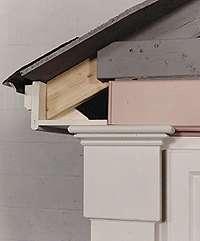 |
Figure 5. Cellular PVC is a type of vinyl that has been foamed and extruded. It is weather-resistant, even if left unpainted. |
In general, cellular PVC is said to machine like wood, and can be mitered. If it is ripped, the cut edges will not be as smooth as the factory edge, since the small entrapped bubbles will be visible. Although ripped edges are just as weather-resistant as factory edges, they are best concealed for reasons of appearance. Cellular PVC can be glued, if necessary, using the same PVC cement used for plumbing pipe.
Most manufacturers of cellular PVC trim offer basic flat stock in typical board dimensions, as well as brickmold. Most trims are sold in 16- or 18-foot lengths.
Foamed polystyrene. Foamed polystyrene has been used for years to manufacture interior moldings. Recently ABTco has introduced a line of foamed polystyrene products, Prime Molding, intended for exterior use. Other manufacturers of foamed polystyrene, including Marley Mouldings, have been reluctant to recommend the use of polystyrene outdoors: "The problem is UV exposure," says Marshall Quina, marketing director at Marley Mouldings. "It can cause the product to degrade." ABTco is selling their foamed polystyrene trim primed, and recommends that it be kept painted. Since this product is brand new, there is little field experience available to back up claims that foamed polystyrene will hold up when used outdoors.
Marty Fajerman, product manager for polystyrene trim at ABTco, was asked if foamed polystyrene has any advantages over cellular PVC. "Styrene is cheaper," said Fajerman. "It costs less to make it." Prime Molding is available as 1x4 nominal flat stock, as a one-piece corner trim, or as brickmold (Figure 6). Wider dimensions are not available. Prime Molding is sold in 10-, 16-, and 17-foot lengths.
 |
Figure 6. ABTco's foamed polystyrene trim, called Prime Molding, is available as brickmold. |
Polymer composite resin. Flex Trim Industries manufactures exterior trim products from a material they describe as a polymer composite resin. Flex Trim pieces are flexible enough to be used as casing on a round-top window, or as a fascia on a round tower. Because of its high cost — for profiles wider than 3 inches, $19 to $44 per linear foot — the material is generally chosen only when flexibility is the most important factor.
Polyethylene lumber. Most polyethy-lene lumber is used for deck boards and picnic tables. However, some builders have experimented with using polyethylene lumber as exterior trim. "We do have a customer who used it to trim windows," says Jim Kerstein, president of Polywood, a manufacturer of polyethylene lumber. Christopher Neville, customer service representative for Renew Products, a manufacturer of polyethylene lumber, says, "We've seen it used as a fascia board."
One employee of a polyethylene lumber manufacturer — who asked not to be identified — doesn't recommend using polyethylene lumber to trim windows and doors. "It isn't suitable, because it expands and contracts too much. It will open up on you."
by Martin Holladay
Martin Holladay is an assistant editor at the Journal of Light Construction.
This article has been provided by www.jlconline.com. JLC-Online is produced by the editors and publishers of The Journal of Light Construction, a monthly magazine serving residential and light-commercial builders, remodelers, designers, and other trade professionals.
Join our Network
Connect with customers looking to do your most profitable projects in the areas you like to work.

